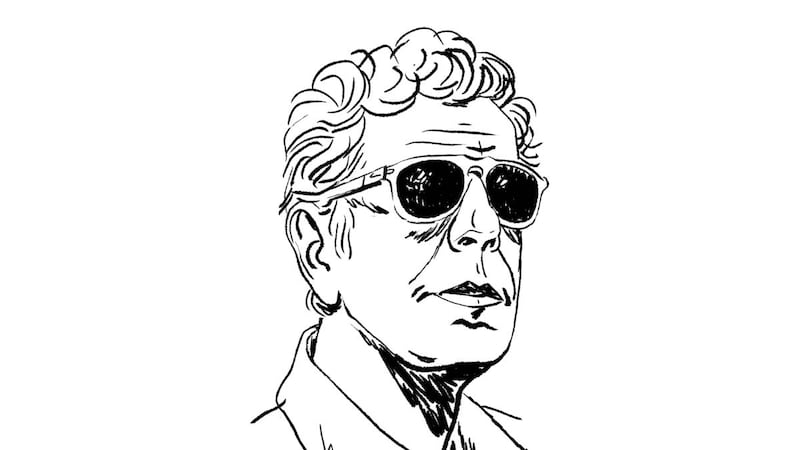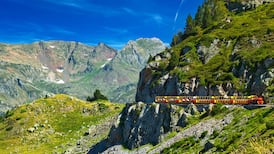“It was never my intention to be a reporter, a critic, an advocate. It was also never my intention to provide audiences with ‘everything’ they needed to know about a place – or even a balanced or comprehensive overview. I am a storyteller. I go places, I come back. I tell you how the places made me feel.
"Through the use of powerful tools like great photography, skilful editing, sound mixing, colour correction, music (which is often composed specifically for the purpose) and brilliant producers, I can – in the very best cases – make you feel a little bit like I did at the time. At least I hope so. It's a manipulative process. It's also a deeply satisfying one."
– Anthony Bourdain, 2012
Did the world need another travel guide, and did we need to write it? In March 2017, when Tony and I began to discuss the idea for this book – an atlas of the world as seen through his eyes (and the lens of television) – I wasn’t entirely sure. He was ever busier and more prolific, with a publishing imprint, an interest in a travel website, and several film and writing passion projects atop his demanding TV career. With so much content out there and in the works, I sometimes felt that we were careening toward “peak Bourdain”.
I had, however, thoroughly enjoyed the process of writing a cookbook (Appetites, published in 2016) with Tony. We met in 2002, when I was hired to edit and test recipes for Anthony Bourdain’s Les Halles Cookbook, his first entry in that category. I started working as his assistant (or, as he liked to say, “lieutenant”) in 2009, and over the years I’d become involved with various editing and writing projects in addition to the more ground-level tasks of an assistant; I wasn’t about to say no when he asked if I’d like to work on another book with him.

It is a hard and lonely thing to coauthor a book about the wonders of world travel when your writing partner, that very traveller, is no longer travelling that world
We worked well together. I’d spent enough time in daily correspondence with Tony to have a good sense of the way he’d choose his words and set his rhythm. He wrote nearly impeccable prose, but on the occasion when it needed a bit of tidying or fleshing out, I was able to do that, I think, without detection.
The publishing business being what it is, and Tony's impossible schedule being what it was, it was nearly a year from that initial conversation to when our work on this book began in earnest. Our first order of business was to sit down and brainstorm what would go into it – the places, people, food, sights, markets, hotels and more that had stuck with him, without aid of notes or videos, throughout nearly 20 years of travelling the world in the service of making television. One spring afternoon in 2018, I sat across from Tony at his dining table, in the Manhattan high-rise apartment he had lovingly styled into a reasonable facsimile of a suite at his favourite Los Angeles hotel, the Chateau Marmont. He'd picked up smoking again, a number of years after quitting; he'd been talking earnestly about a plan to stop, but in the meantime, in response to complaints from his neighbours, he'd recently installed an industrial-strength smoke-eater machine, of the kind and calibre normally seen only in casinos and bars.
I’d chosen my seat, under the ceiling-mounted contraption, rather poorly: while Tony chain-smoked and free-associated for over an hour, recalling best-loved dishes and hotels and people, the machine’s powerful vacuum sucked the smoke across my face and into its maw. I left the apartment smelling like a late-1990s bar crawl through hell, but in possession of an hour-long audio recording in which we’d laid out a blueprint for the book, a window into what had shaped his understanding and appreciation for some of the world’s most interesting places, as he tirelessly explored and documented them.
Exploring the world
After this conversation, Tony went back out to keep exploring the world for his television show Parts Unknown – Kenya, Texas, Manhattan's Lower East Side, Indonesia – while I started to track down old episodes, began to painstakingly transcribe the relevant bits, and wrote lists of questions. My plan was to get a few chapter outlines completed and hand them to Tony, to make sure we were on the same page, and to get him started on filling in the juice, the essential Tony-ness. Only, I never got a chance.
If I’d known that that single meeting would be the only one we’d have about the book, I would have pushed him for more specifics in those places where he’d said “let’s come back to it” or “see what you can pull up”. It is a hard and lonely thing to coauthor a book about the wonders of world travel when your writing partner, that very traveller, is no longer travelling that world. And, to be honest, in the difficult days and weeks after his death, I once again found myself asking, “Does the world need this book?”

I have recruited a number of Tony's friends, family members and colleagues to contribute their own collected thoughts and memories
Of great comfort in the immediate aftermath of Tony’s departure – and even now, more than two years later – is the steady chorus of admiration for what he accomplished while he was here, and the expressions of deep sorrow over the loss of him, from many corners of the world. The sheer magnitude of his cultural impact became clear to me only after he died.
Maybe the world could use another travel guide, full of Tony’s acid wit and thoughtful observations and a few sly revelations of the mysterious contours of his battered heart, stitched together from all the brilliant and hilarious things he’d said and written about the world as he saw it.
We had initially planned for Tony to write a number of essays about specific topics that moved him: his abiding love of France; the countries in which he was no longer welcome, by decree of one irritated government or another; the eccentricities of various European palates; a specific onsen outside Kyoto that was so hushed, luxurious and polished that it remained his favourite, even after many return trips to Japan.
Collected thoughts
He was gone before having the chance to write those essays, so I have recruited a number of Tony's friends, family members and colleagues to contribute their own collected thoughts and memories about places they experienced with Tony. You'll find recollections of visits to France, Uruguay and the New Jersey shore from Tony's brother, Christopher Bourdain; a story from Tony's producer and director Nari Kye of coming to terms with her Korean roots while shooting in Seoul; the producer and musician Steve Albini on the places he wishes he could share a meal with Tony in Chicago, and more.
While the book does include basic information on topics like transportation and hotels, it is far from a comprehensive guide to any one location. Prices, exchange rates, travel routes, geopolitical stability, and the business of making and selling food and beverages are all flexible, changing things; for the most up- to-date and detailed information about how to take a train between Ho Chi Minh City and Hanoi, say, or exactly which buses will get you from Midtown Manhattan to the Bronx, you will want to supplement the volume with a fat, full-colour guidebook dedicated to one city or country, or, you know, the internet.

There are risks, and there are rewards, of being exposed to the entire world's hunger to eat, travel and live like Tony
Please note, too, that in certain cases, some of Tony’s quotes have been slightly edited or condensed for clarity; these quotes have been pulled from a variety of sources, chief among them the written transcripts of his television shows No Reservations, The Layover and Parts Unknown, along with the various essays Tony wrote in support of certain episodes, and, on occasion, remarks he made to various publications about a specific person or place.
Stick to the plan
I have tried, as much as possible, to stick to the plan for this book as Tony laid it out. In some cases, a beloved restaurant or bar has permanently closed, or had a change of ownership and with it a change in product, ambience, or attitude. And in some cases, a business has succumbed to the “Bourdain effect”, which is to say, once a low-key restaurant or bar or sausage kiosk was featured on the show, its number of customers often skyrocketed, with Bourdain-inspired pilgrims showing up in droves to try the thing that Tony had on camera. In theory, this was a good thing, a coveted thing for businesses, but it could also utterly disrupt a beloved local institution, turning it into a sideshow or, depending on how the business handled it, a shitshow. Tony and his crew were aware of this possibility, and sensitive to it, though of course it was ultimately a decision each business owner made.
There are risks, and there are rewards, of being exposed to the entire world’s hunger to eat, travel and live like Tony.
"Who gets to tell the stories?" asked Tony on the Kenya episode of Parts Unknown, which he made with his CNN colleague W Kamau Bell. It was the last episode for which he recorded narration, and the winner, in 2019, of an Emmy Award for television writing.
“This is a question asked often. The answer, in this case, for better or for worse, is, ‘I do.’ At least this time out. I do my best. I look. I listen. But in the end, I know: it’s my story, not Kamau’s, not Kenya’s, or Kenyans’. Those stories are yet to be heard.”
This is an extract from World Travel: An Irreverent Guide by Anthony Bourdain with Laurie Woolever, published by Bloomsbury Publishing and out now in hardback.











